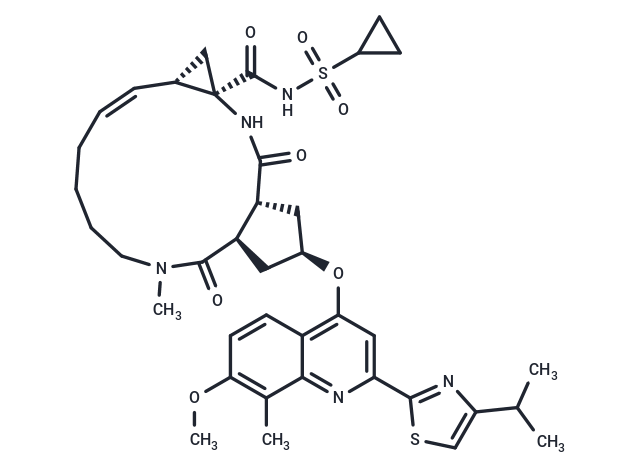Shopping Cart
- Remove All
 Your shopping cart is currently empty
Your shopping cart is currently empty

Simeprevir (TMC435) is a potent HCV NS3/4A protease inhibitor, and inhibits HCV replication with EC50 of 8 nM.

| Pack Size | Price | Availability | Quantity |
|---|---|---|---|
| 2 mg | $30 | In Stock | |
| 5 mg | $46 | In Stock | |
| 10 mg | $61 | In Stock | |
| 25 mg | $85 | In Stock | |
| 50 mg | $126 | In Stock | |
| 100 mg | $198 | In Stock | |
| 1 mL x 10 mM (in DMSO) | $68 | In Stock |
| Description | Simeprevir (TMC435) is a potent HCV NS3/4A protease inhibitor, and inhibits HCV replication with EC50 of 8 nM. |
| Targets&IC50 | HCV:8 nM (EC50) |
| In vitro | In Huh7-Luc cells, antiviral activity of simeprevir (Simeprevir) is dose dependent, and the EC50 and EC90 values determined for Simeprevir are 8 nM and 24 nM, respectively. Inhibition of Simeprevir on NS3/4A protease is time dependent, and the overall Kis are estimated to be 0.5 nM for genotype 1a and 0.4 nM for genotype 1b, respectively. Simeprevir is a potent inhibitor of HCV NS3/4A protease (Ki=0.36 nM) and viral replication (replicon EC50=7.8 nM). |
| In vivo | In rats, TMC435350 (40 mg/kg, p.o.) is extensively distributed to the liver and intestinal tract (tissue/plasma area under the concentration-time curve ratios of >35), and the absolute bioavailability is 44%. |
| Kinase Assay | In vitro inhibition of NS3/4A activity is determined using a fluorescence resonance energy transfer cleavage assay with the RetS1 peptide substrate, derived from the genotype 1a NS4A-4B junction, and bacterially expressed full-length NS3 protease domain, supplemented with an NS4A peptide. Briefly, NS3/4A is preincubated in the presence of TMC435350 for 10 min, and then the RetS1 substrate is added and fluorescence is continuously measured for 20 min (excitation, 355 nm; emission, 500 nm). Cleavage of the substrate is expressed as a percentage of the cleavage seen with the vehicle control. |
| Cell Research | Huh7-Luc cells are seeded at a density of 2,500 cells/well in a 384-well plate in Dulbecco's modified Eagle's medium plus 10% fetal calf serum and incubated with a range of concentrations of serially diluted simeprevir, in a final DMSO concentration of 0.5% in the absence of G418. After 72 h of incubation, Steady Lite reagent is added in a 1:1 ratio to the medium, and luciferase signal is measured using a ViewLux reader. |
| Animal Research | Twenty-four male specific-pathogen-free Sprague-Dawley rats, weighing between 200 and 300 g at the time of dosing, are divided into eight groups of three rats each. Seven groups are dosed orally (p.o.) by gastric intubation of a vitamin E acetate-d-α-tocopheryl polyethylene glycol 1000 succinate-polyethylene glycol 400 solution of Simeprevir (TMC435350) at 2 mL/kg body weight to provide a dose of 40 mg/kg. One group is dosed intravenously (i.v.) by slow bolus injection in a tail vein of a 20% 2-hydroxypropyl-β-cyclodextrin formulation of TMC435350 (containing TMC435350, 100 mg/mL 2-hydroxypropyl-β-cyclodextrin, 0.1 N NaOH to pH 8.0±0.1, and mannitol-and pyrogen-free water) at 2 mL/kg body weight to provide a dose of 4 mg/kg. Water and food are available ad libitum during the study. |
| Alias | TMC-435350, TMC435, Olysio |
| Molecular Weight | 749.94 |
| Formula | C38H47N5O7S2 |
| Cas No. | 923604-59-5 |
| Smiles | COc1ccc2c(O[C@@H]3C[C@@H]4[C@@H](C3)C(=O)N(C)CCCC\C=C/[C@@H]3C[C@]3(NC4=O)C(=O)NS(=O)(=O)C3CC3)cc(nc2c1C)-c1nc(cs1)C(C)C |
| Relative Density. | 1.38 |
| Storage | Powder: -20°C for 3 years | In solvent: -80°C for 1 year | Shipping with blue ice. | ||||||||||||||||||||||||||||||
| Solubility Information | DMSO: 55 mg/mL (73.34 mM) H2O: Insoluble | ||||||||||||||||||||||||||||||
Solution Preparation Table | |||||||||||||||||||||||||||||||
DMSO
| |||||||||||||||||||||||||||||||

Copyright © 2015-2024 TargetMol Chemicals Inc. All Rights Reserved.